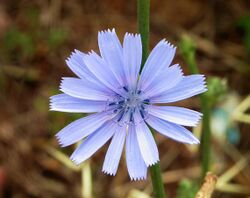Biology:Cichorium
| Cichorium | |
|---|---|

| |
| Wild endive (Cichorium pumilum) | |
| Scientific classification Error creating thumbnail: Unable to save thumbnail to destination
| |
| Kingdom: | Plantae |
| Clade: | Tracheophytes |
| Clade: | Angiosperms |
| Clade: | Eudicots |
| Clade: | Asterids |
| Order: | Asterales |
| Family: | Asteraceae |
| Subfamily: | Cichorioideae |
| Tribe: | Cichorieae |
| Subtribe: | Cichoriinae |
| Genus: | Cichorium L. |
| Type species | |
| Cichorium intybus[1][2] | |
| Synonyms[3] | |
| |
Cichorium is a genus of plants in the tribe Cichorieae within the family Asteraceae.[4][2] The genus includes two cultivated species commonly known as chicory or endive, plus several wild species.[5]

Common chicory (Cichorium intybus) is a bushy perennial herb with blue or lavender (or, rarely, white or pink) flowers. It grows as a wild plant on roadsides in its native Europe, and in North America, where it has become naturalized. It is grown for its leaves, when it is known as leaf chicory, endive, radicchio, Belgian endive, French endive, or witloof. Other varieties are grown for their roots, which are used as a coffee substitute, similar to dandelion coffee.
True endive (Cichorium endivia) is a species grown and used as a salad green. It has a slightly bitter taste. Curly endive and the broad-leafed escarole are true endives.
Cichorium is used as a food plant by the larvae of some Lepidoptera species including setaceous Hebrew character, turnip moth, and the grass moth Diasemia reticularis.
- Species[3]
- Cichorium alatum Hochst. & Steud. - Europe, Arabian Peninsula, drier parts of Africa from Algeria to Namibia[6]
- Cichorium bottae Deflers - Saudi Arabia, Yemen
- Cichorium callosum Pomel - North Africa
- Cichorium calvum Sch.Bip. ex Asch. - Egypt, Ethiopia, Palestine (region), Jordan
- Cichorium dubium E.H.L.Krause - Europe
- Cichorium endivia L. - Mediterranean
- Cichorium hybridum Halácsy - Greece
- Cichorium intybus L. - probably Europe; now very widespread invasive
- Cichorium pumilum Jacq. - Mediterranean
- Cichorium spinosum L. - Mediterranean
Formerly included[3] are several species[which?] now considered better suited to other genera: Aposeris, Arnoseris, Geigeria, Rhagadiolus and Tolpis.
References
- ↑ lectotype designated by Green, Prop. Brit. Bot.: pg 178. 1929
- ↑ 2.0 2.1 Tropicos, Cichorium L.
- ↑ 3.0 3.1 3.2 Flann, C (ed) 2009+ Global Compositae Checklist
- ↑ Linnaeus, Carl von. 1753. Species Plantarum 2: 813
- ↑ Altervista Flora Italiana, genere Cichorium includes photos and distribution maps for 4 species
- ↑ Kyffhäuser flora
External links
- Chicory Pollinators Diagnostic photographs; insect pollinators of chicory
- Cichorium pumilum in Wildflowers of Israel
Wikidata ☰ Q158514 entry
 |

